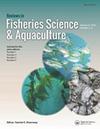Genetic Diversity of Captive and Wild Threatened Catfish Pseudoplatystoma corruscans in the São Francisco River
引用次数: 13
Abstract
A genetic analysis was conducted of the critically endangered migratory catfish Pseudoplatystoma corruscans from the São Francisco River basin, the basin with the second highest hydropower capacity installed in Brazil. The analysis was conducted using five microsatellite markers previously described in the literature. Genetic diversity was analyzed and compared in three wild populations and a captive broodstock for a restocking program. Catfish populations of this river showed high genetic diversity in terms of heterozygosities; however, only half of the total number of alleles found in other basins were detected. Seven private alleles occurred in this basin and most of them at low frequencies, indicating they are under threat of extinction. Overall FST and assignment test suggested low differentiation among the three wild populations; however, a marked distinction between these populations and the captive broodstock was observed. The number of alleles and low average relatedness estimates found for the captive population suggest that it could be used for restocking in areas where the wild population has collapsed, but should not be used for stock enhancement in areas where the wild population is extant. These results are important as a reference for genetic aspects that should be considered in fish management activities.对巴西水力发电装机容量第二高的奥弗朗西斯科河流域极度濒危的洄游鲶鱼Pseudoplatystoma corruscans进行了遗传分析。分析是使用先前文献中描述的五个微卫星标记进行的。分析和比较了3个野生种群和1条圈养亲鱼的遗传多样性。该河鲶鱼种群在杂合性方面表现出较高的遗传多样性;然而,在其他盆地中发现的等位基因总数仅为一半。该盆地共有7个私有等位基因,且频率较低,表明它们面临灭绝的威胁。总体FST和分配试验表明,3个野生居群分化程度较低;然而,观察到这些种群与圈养亲鱼之间有明显区别。在圈养种群中发现的等位基因数量和较低的平均亲缘性估计表明,它可以用于野生种群减少的地区的补充,但不应用于野生种群存在的地区的种群增加。这些结果对于鱼类管理活动中应考虑的遗传方面具有重要的参考意义。
本文章由计算机程序翻译,如有差异,请以英文原文为准。
求助全文
约1分钟内获得全文
求助全文

 求助内容:
求助内容: 应助结果提醒方式:
应助结果提醒方式:


